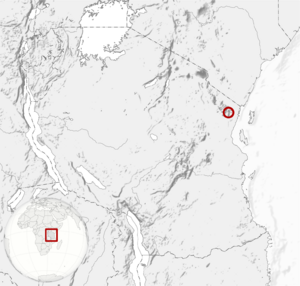Amanipodagrion facts for kids
Quick facts for kids Amanipodagrion |
|
|---|---|
 |
|
| Distribution of the species Amanipodagrion gilliesi | |
| Conservation status | |
| Scientific classification | |
| Genus: |
Amanipodagrion
|
| Species: |
gilliesi
|
The Amanipodagrion gilliesi is a special type of damselfly. It is also known as the Amani flatwing. This tiny insect is very rare. It lives only in a small part of Tanzania, Africa. Scientists recently gave it its very own family name: Amanipodagrionidae. This shows how unique it is! Sadly, the Amani flatwing is in great danger. It is listed as "critically endangered" because its home is disappearing.
Contents
What Does the Amani Flatwing Look Like?
The Amani flatwing has a long, very thin body. Its body is dark, but it has a bright white tip. Its wings are special too. They are narrower near its body and wider at the ends. Male Amani flatwings have a wide brown band near the tips of their wings.
Where Does the Amani Flatwing Live?
This damselfly lives only in a specific place. It is found in the Amani Sigi Forest in the eastern Usambara Mountains of Tanzania. Most Amani flatwings live along a 500-meter (about 1,640 feet) stretch of stream. This stream is inside the Amani-Sigi Forest Reserve. Only one male has been found outside this small area.
What Kind of Home Does it Like?
Adult Amani flatwings like to live near clear, fast-flowing streams. These streams must be heavily shaded. They prefer areas where tall trees form a closed canopy overhead. Their natural habitats are warm, wet lowland forests and rivers.
Why is the Amani Flatwing in Danger?
The Amani flatwing is now critically endangered. This means it is very close to becoming extinct. Its main problem is the destruction of its home. Many low-altitude forests in East Africa have been cut down. People often clear these forests to create farmland.
The few remaining forests in the East Usambara Mountains are also under threat. These are the forests where the Amani flatwing lives. The main group of Amani flatwings is safe inside the Amani-Sigi Forest Reserve. However, other groups nearby might already be gone. This is due to people moving into the area and cutting down trees. Water pollution also harms them. There are fewer than 250 adult Amani flatwings left in the protected area.
How Can We Help the Amani Flatwing?
The stream where the main group of Amani flatwings lives is protected. It is part of the forest reserve. This helps keep them safe from some dangers. However, any big changes to this stream could cause the species to disappear forever.
Experts believe we need to search the whole area. This would help find any other groups of Amani flatwings. It is very important because this species is very close to becoming extinct. Also, damselflies and dragonflies do not survive well in captivity. This makes protecting their natural home even more important.


